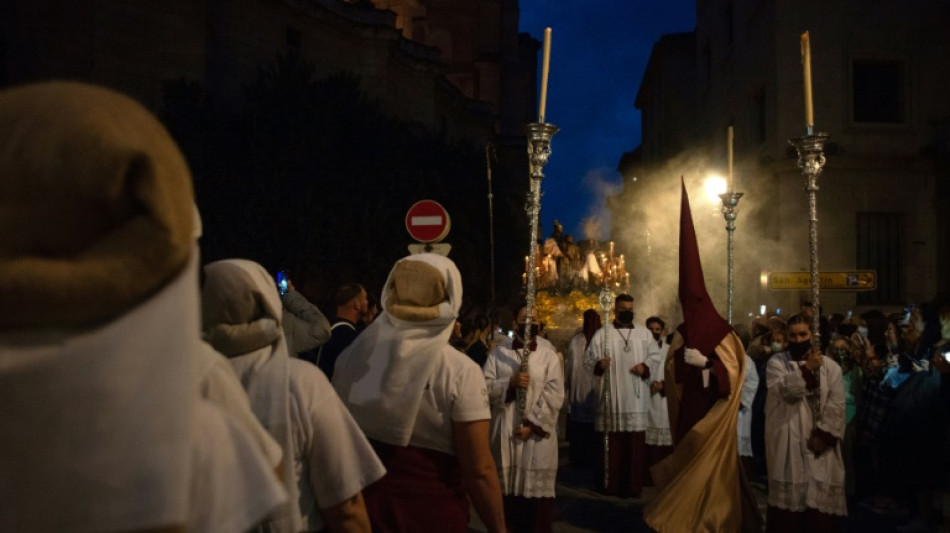
-
 Lebanon said studying US truce plan for Israel-Hezbollah war
Lebanon said studying US truce plan for Israel-Hezbollah war
-
Xi warns against 'protectionism' at APEC summit under Trump cloud

-
 Nigerian UN nurse escapes jihadist kidnappers after six years
Nigerian UN nurse escapes jihadist kidnappers after six years
-
India in record six-hitting spree to rout South Africa

-
 George tells England to prepare for rugby 'war' against Springboks
George tells England to prepare for rugby 'war' against Springboks
-
Pogba's Juve contract terminated despite doping ban reduction

-
 Ukraine slams Scholz after first call with Putin in two years
Ukraine slams Scholz after first call with Putin in two years
-
Michael Johnson's Grand Slam Track series to have LA final

-
 Kagiyama, Yoshida put Japan on top at Finland Grand Prix
Kagiyama, Yoshida put Japan on top at Finland Grand Prix
-
Alcaraz eyeing triumphant Davis Cup farewell for Nadal after ATP Finals exit

-
 Xi, Biden at Asia-Pacific summit under Trump trade war cloud
Xi, Biden at Asia-Pacific summit under Trump trade war cloud
-
India go on record six-hitting spree against South Africa

-
 France skipper Dupont says All Blacks 'back to their best'
France skipper Dupont says All Blacks 'back to their best'
-
Trump pressures US Senate with divisive cabinet picks

-
 Bagnaia strikes late in Barcelona practice to edge title rival Martin
Bagnaia strikes late in Barcelona practice to edge title rival Martin
-
High-ball hero Steward ready to 'front up' against South Africa

-
 Leader of Spain flood region admits 'mistakes'
Leader of Spain flood region admits 'mistakes'
-
Swiatek, Linette take Poland past Spain into BJK Cup quarter-finals

-
 Leftist voices seek to be heard at Rio's G20 summit
Leftist voices seek to be heard at Rio's G20 summit
-
Wales coach Jenkins urges players to 'get back on the horse'

-
 Zverev reaches ATP Finals last four, Alcaraz out
Zverev reaches ATP Finals last four, Alcaraz out
-
Boeing strike will hurt Ethiopian Airlines growth: CEO

-
 Springboks skipper Kolisi wary of England's 'gifted' Smith
Springboks skipper Kolisi wary of England's 'gifted' Smith
-
End of a love affair: news media quit X over 'disinformation'

-
 US finalizes up to $6.6 bn funding for chip giant TSMC
US finalizes up to $6.6 bn funding for chip giant TSMC
-
Scholz urges Ukraine talks in first call with Putin since 2022

-
 Zverev reaches ATP Finals last four, Alcaraz on brink of exit
Zverev reaches ATP Finals last four, Alcaraz on brink of exit
-
Lebanon rescuer picks up 'pieces' of father after Israel strike

-
 US retail sales lose steam in October after hurricanes
US retail sales lose steam in October after hurricanes
-
Zverev reaches ATP Finals last four with set win against Alcaraz

-
 Kerevi back for Australia against Wales, Suaalii on bench
Kerevi back for Australia against Wales, Suaalii on bench
-
Spate of child poisoning deaths sparks S.Africa xenophobia

-
 Comedian Conan O'Brien to host Oscars
Comedian Conan O'Brien to host Oscars
-
Rozner overtakes McIlroy and Hatton for Dubai lead

-
 Mourners bid farewell to medic killed in east Ukraine
Mourners bid farewell to medic killed in east Ukraine
-
Gore says 'absurd' to hold UN climate talks in petrostates

-
 Hamas says 'ready for ceasefire' as Israel presses Gaza campaign
Hamas says 'ready for ceasefire' as Israel presses Gaza campaign
-
Amorim says Man Utd is 'where I'm supposed to be'

-
 Japan hammer Indonesia to edge closer to World Cup spot
Japan hammer Indonesia to edge closer to World Cup spot
-
Jeff Beck guitar collection to go under the hammer in January

-
 Veteran Ranieri has 'no time for mistakes' on Roma return
Veteran Ranieri has 'no time for mistakes' on Roma return
-
Van Nistelrooy says he will 'cherish' Man Utd memories in farewell message

-
 IAEA chief tours sensitive Iran nuclear plants
IAEA chief tours sensitive Iran nuclear plants
-
Pompeii rejects 'mass tourism' with daily visitor limit

-
 Jailed Russian poet could be 'killed' in prison, warns wife
Jailed Russian poet could be 'killed' in prison, warns wife
-
French court orders release of Lebanese militant held since 1984

-
 Global stocks struggle after Fed signals slower rate cuts
Global stocks struggle after Fed signals slower rate cuts
-
UK economy slows, hitting government growth plans

-
 Primary schools empty as smog persists in Indian capital
Primary schools empty as smog persists in Indian capital
-
Palestinians turn to local soda in boycott of Israel-linked goods

| CMSC | -0.02% | 24.545 | $ | |
| RBGPF | 2.67% | 61.84 | $ | |
| NGG | 0.49% | 62.68 | $ | |
| GSK | -1.75% | 33.415 | $ | |
| RELX | -3.61% | 44.35 | $ | |
| AZN | -2.85% | 63.235 | $ | |
| CMSD | 0.14% | 24.3924 | $ | |
| SCS | -0.15% | 13.25 | $ | |
| RIO | 0.87% | 60.96 | $ | |
| RYCEF | -0.15% | 6.78 | $ | |
| BCC | -0.22% | 140.036 | $ | |
| BTI | 2.26% | 36.309 | $ | |
| JRI | -0.4% | 13.025 | $ | |
| VOD | 0.86% | 8.755 | $ | |
| BP | -0.43% | 28.925 | $ | |
| BCE | -0.04% | 26.83 | $ |

Women bear weight of Easter rite in changing Spain
The team of women rocked rhythmically from foot to foot carrying a 1.5-tonne float topped with a statue of Jesus and Mary on the streets of Granada in southern Spain.
The 50 women supported the weight on wooden ribs under the belly of the float as they inched forward through the city for ten hours on Monday.
A heavy velvet cloth draped over the float left only their white shoes visible to throngs of spectators lining the route.
The parades featuring dozens of people dressed in religious tunics and distinctive pointy hoods have returned this Holy Week after being cancelled due to the Covid-19 pandemic the past two years.
While religious orders started allowing women to carry floats in Spain's famous Easter processions 30 years ago, female "costaleros" -- as float bearers are known -- remain a minority who still face resistance.
Women have traditionally formed the back line of the processions, playing the role of mourners dressed in stylish black dresses, embroidered veils and intricately designed hair combs.
Granada's "Work and Light" brotherhood was among the first to allow women to carry the floats in the 1980s.
At first "it was not accepted, women were talked bad about," said Pilar del Carpio, a 45-year-old cashier who has been a shrine bearer since she was 13 and is proud to be one of the "pioneers".
Today only three or four of Granada's 30 brotherhoods, which stage the processions, include women costaleras.
"Maybe there are people who think it is not normal," said Maria Auxiliadora Canca, a 40-year driving instructor who directs a team of float bearers in Ronda, another Andalusia city in southern Spain.
"Since our bodies are capable of doing it, and we do it with conviction, I don't see why there should be a difference."
- 'Scandal' -
But in Seville, which holds Spain's most spectacular Easter parades, there are no women float bearers even though the city's archbishop in 2011 issued a decree to put an end to gender-based discrimination in the city's religious orders.
Opponents claim the task is too physically demanding, "not suitable" for women.
"It's a scandal," said Maribel Tortosa, 23, who manages an Instagram account called "Costaleras por Sevilla" dedicated to women float bearers.
People say that it is "ugly" to see a woman wearing a "costal", the traditional padded sack used by bearers as protective headgear, she said.
"But under a float, you don't see anything," she added.
Still, the emergence of women float bearers reflects the growing push by women in Spain into traditionally male-dominated fields since the return of democracy in the 1970s.
Spain's oldest police force, the Guardia Civil, has since 2020 been headed by a woman -- a first in its 178-year history.
And since Socialist Prime Minister Pedro Sanchez came to power in 2018, women have taken up most cabinet posts for the first time in history.
- 'Strong enough' -
In Granada, locals are no longer surprised to see women training on the streets in the lead up to Holy Week by lifting and carrying a float loaded with bricks.
The load "weighs more every hour", even though the shrine bearers are replaced every half hour during the "Work and Light" brotherhood's procession, which began Monday at four pm and ended at around one am, said Rafael Perez, who heads the team of women shrine bearers.
Working with women "changes absolutely nothing. I just have to treat them with more tenderness," said Perez.
Among the women of this religious order was Montse Rios, 47, who has been a bearer since she was 19 and who still feels "strong enough to go under".
Her eldest daughter joined her this week under the float, while her youngest is a "pipera", giving water to the procession participants.
"And we don't lack that," she added.
E.Hall--AT


